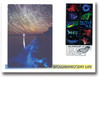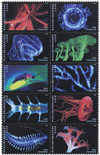
# 5264-73 - 2018 First-Class Forever Stamp - Bioluminescent Life
US #5264-73
2018 Bioluminescent Life
- Showcases the wonders of bioluminescence in nature
Stamp Category: Commemorative
Value: 50¢ First Class Mail Rate (Forever)
First Day of Issue: February 22, 2018
First Day City: Fort Pierce, Florida
Quantity Issued: 40,000,000
Printed by: Banknote Corporation of America
Printing Method: Offset
Format: Panes of 20
Tagging: Phosphor tagged paper, block tag
Other: These stamps are highly reflective with a rainbow holographic-style effect
Why the stamps were issued: To celebrate different organisms capable of generating their own light (bioluminescent).
About the stamp designs: Each of the 10 designs pictures existing photographs of bioluminescent organisms taken by Dr. Edith Widder, Taylor F. Lockwood, Gail Shumway, and Steve Haddock.
Rainbow reflectivity: According to the USPS, these stamps were “produced using a proprietary rainbow holograph material that is highly reflective in white light. The stamps were produced using special techniques to enhance the reflective qualities of the material while maintaining the depth of color and detail of the individual images. The rainbow pattern imparts a sense of movement and light to the stamp pane.”
First Day City: The First Day of Issue Ceremony was held at Sunrise Theater in Fort Pierce, Florida, not far from the Ocean Research and Conservation Association headquarters (ORCA). The organization’s CEO and Senior Scientist, Dr. Edith Widder, provided photographs for seven of the stamps images and was also in attendance at the First Day of Issue Ceremony.
History the stamp represents: From the deepest depths of the ocean, to jungles, to our own backyards, nature puts on an elaborate light show of bioluminescence. Thousands of lifeforms have the ability to glow, but they all use it for different purposes.
Bioluminescence is the creation and emission of light from a living organism. It’s most often found in deep-sea creatures – in fact, about 76 percent of deep-sea animals produce light. There are also plankton that live on the surface of the ocean that are bioluminescent and can make the water appear to glow at night.
The ways in which creatures utilize their bioluminescence can be as varied as the organisms themselves. Some use their mesmerizing lights to attract prey, while others use them to scare off predators. Others, like the atolla jellyfish, flash bright lights to attract their predators’ enemies, earning them the nickname “alarm jellyfish.” Some may also use their light as a way to blend in, as with the cookiecutter shark. This shark’s underside is almost entirely luminescent, matching the color of the ocean around it. A small dark band on its neck resembles a small fish, which attracts prey that the shark then takes a single bite out of. This bite was the inspiration for its name.
Not all bioluminescent life is at the bottom of the ocean. In temperate forests around the world (including the US), mushrooms glow to attract insects which spread their spores. Fireflies are another example of a bioluminescent species which can be found in most parts of the world. Unlike most other creatures, fireflies glow to attract potential mates. No matter their purpose, bioluminescence species always put on a great light show.
US #5264-73
2018 Bioluminescent Life
- Showcases the wonders of bioluminescence in nature
Stamp Category: Commemorative
Value: 50¢ First Class Mail Rate (Forever)
First Day of Issue: February 22, 2018
First Day City: Fort Pierce, Florida
Quantity Issued: 40,000,000
Printed by: Banknote Corporation of America
Printing Method: Offset
Format: Panes of 20
Tagging: Phosphor tagged paper, block tag
Other: These stamps are highly reflective with a rainbow holographic-style effect
Why the stamps were issued: To celebrate different organisms capable of generating their own light (bioluminescent).
About the stamp designs: Each of the 10 designs pictures existing photographs of bioluminescent organisms taken by Dr. Edith Widder, Taylor F. Lockwood, Gail Shumway, and Steve Haddock.
Rainbow reflectivity: According to the USPS, these stamps were “produced using a proprietary rainbow holograph material that is highly reflective in white light. The stamps were produced using special techniques to enhance the reflective qualities of the material while maintaining the depth of color and detail of the individual images. The rainbow pattern imparts a sense of movement and light to the stamp pane.”
First Day City: The First Day of Issue Ceremony was held at Sunrise Theater in Fort Pierce, Florida, not far from the Ocean Research and Conservation Association headquarters (ORCA). The organization’s CEO and Senior Scientist, Dr. Edith Widder, provided photographs for seven of the stamps images and was also in attendance at the First Day of Issue Ceremony.
History the stamp represents: From the deepest depths of the ocean, to jungles, to our own backyards, nature puts on an elaborate light show of bioluminescence. Thousands of lifeforms have the ability to glow, but they all use it for different purposes.
Bioluminescence is the creation and emission of light from a living organism. It’s most often found in deep-sea creatures – in fact, about 76 percent of deep-sea animals produce light. There are also plankton that live on the surface of the ocean that are bioluminescent and can make the water appear to glow at night.
The ways in which creatures utilize their bioluminescence can be as varied as the organisms themselves. Some use their mesmerizing lights to attract prey, while others use them to scare off predators. Others, like the atolla jellyfish, flash bright lights to attract their predators’ enemies, earning them the nickname “alarm jellyfish.” Some may also use their light as a way to blend in, as with the cookiecutter shark. This shark’s underside is almost entirely luminescent, matching the color of the ocean around it. A small dark band on its neck resembles a small fish, which attracts prey that the shark then takes a single bite out of. This bite was the inspiration for its name.
Not all bioluminescent life is at the bottom of the ocean. In temperate forests around the world (including the US), mushrooms glow to attract insects which spread their spores. Fireflies are another example of a bioluminescent species which can be found in most parts of the world. Unlike most other creatures, fireflies glow to attract potential mates. No matter their purpose, bioluminescence species always put on a great light show.



















